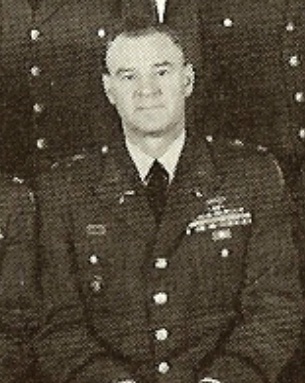One of the frequently mentioned characters in Clark’s diary is Colonel James E. Williams, the commander of the 2d Brigade, 1st Infantry Division. Clark knew Williams from Leavenworth, where he served as the Director of Large Unit Operations at CGSC from 1962-1965. The Army gave Williams command of the 2d Brigade, 1st Infantry Division, in the spring of 1965 just as the unit prepared to deploy to South Vietnam. On 20 June 1965, Simmons and an advance party of brigade staff officers and battalion commanders flew to Vietnam and made arrangements for the brigade's arrival.
 |
| Colonel James E. Williams, U.S. Army. (Photo courtesy U.S. Army) |
In 1965, the 2d Brigade was composed of the 2d Battalion, 16th Infantry; the 1st and 2d Battalions, 18th Infantry; the 1st Battalion, 7th Artillery; Battery C, 8th Battalion, 6th Artillery; and various support units, including engineer, maintenance, medical, police, military intelligence, and signal intercept companies. During the first half of June the brigade loaded its equipment on railroad cars for shipment to California. The first train left Fort Riley, Kansas, on 14 June. Between 21 June and 24 June, the rest of the unit traveled by rail and air to the Oakland, California Army Terminal. On 25 June, the brigade embarked on the U.S.Navy transport General W.H. Gordon, while three other ships moved the brigade's equipment. Once the ship was under way, Simmons officially informed the troops what they had already suspected: They were en route to Vietnam. [1]
Simmons and his brigade experienced many difficulties throughout the summer of 1965. Westmoreland and DePuy changed the 2d Brigade's destination and mission a week before its arrival in Vietnam. Originally, the brigade was tasked with establishing and maintaining defenses for port and supply facilities at Qui Nhon; instead, MACV divided the brigade and sent two of the unit's infantry battalions, the 2d Battalion, 16th Infantry, and the 2d Battalion, 18th Infantry, to Bien Hoa to assist the 173d Airborne Brigade with securing the air base. MACV ordered the third battalion, the 1st Battalion, 18th Infantry, and an artillery battery to Cam Ranh Bay, 200 kilometers south of Qui Nhon, to provide security for the port.
 |
| The 2d Brigade, 1st Infantry Division arrives at Vung Tau, 14 July 1965. (Photo courtesy U.S. Army) |
Movements Branch's role in the deployment began when the Gordon reached Cam Ranh Bay on 12 July, where the troop ship docked to allow the infantry and artillery to disembark. Clark arranged for LSTs and LCUs to move the troops from the Gordon to Cam Ranh. The ship continued south and arrived at Vung Tau on 14 July. Over the next two days Movements Branch arranged for the troops to move by LST and LCU to Vung Tau port; from there, the troops made their way to the Vung Tau airfield, where Movements Branch arranged for their airlift to Bien Hoa Air Base. Upon arrival, Movements Branch arranged the brigade to be moved by truck to their prospective base camp, about three kilometers southeast of the airfield, a site chosen because it lay astride a line of approach into the air base. For its first few days in Vietnam, Simmons' force was under the command of MACV; on 19 July, the 173d Airborne Brigade assumed operational control of the 2d Brigade. This arrangement continued until the 1st Infantry Division headquarters deployed to Vietnam in October 1965. This command arrangement also significantly affected Colonel Simmons, as Clark related in the diary in September 1965. [2]
Westmoreland and DePuy's decision to change the 2d Brigade's station from Qui Nhon to Bien Hoa created supply problems for Simmons and for Movements Branch. Clark and his branch had arranged the movement and preposition of food stores and ammunition for the brigade at Qui Nhon. Now that supply was unavailable and difficult for Movements Branch to transport to Bien Hoa while tactical operations and the imminent arrival of additional combat units were ongoing. The existing Army and Navy warehouses scattered around Saigon had difficulty supporting the troop buildup and could afford the brigade only minimal help. Throughout the summer, Simmons' brigade existed on a thin logistical shoestring and only the U.S. Navy HSAS commissary at Cholon kept the troops of the brigade from subsisting on field rations for months at a time. Ominously, the brigade's ammunition supply became so depleted during combat operations that Simmons had to borrow artillery rounds from South Vietnamese units. As Clark will explain in future diary entries, Simmons asked Movements Branch to help airlift supplies to his unit. [3]
_______________________________________________________________________________
NOTES
[1] [Unit History, 1965], 2d Bde, 1st Inf Div, pp. [2-3].
[2] Quarterly Cmd Rpt, 1 Jul-30 Sep 65, 2d Bde, 1st Inf Div, 16 Oct 65, pp. 2-3.
[3] Quarterly Cmd Rpt, 1 Jul-30 Sep 65, 2d Bde, 1st Inf Div, p. 9.

The article mistakenly refers to Col. James E. Simmons as “Williams.” I am married to his daughter.
ReplyDelete